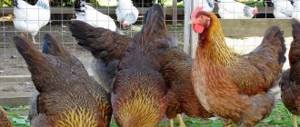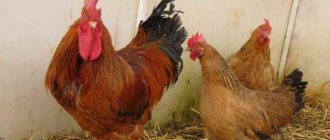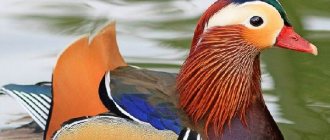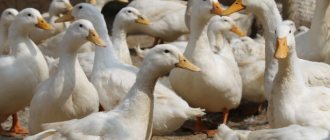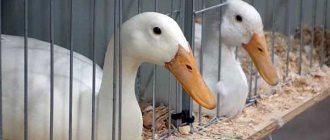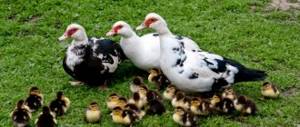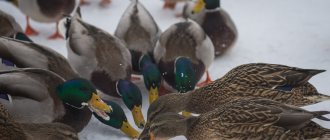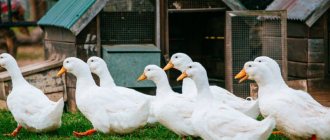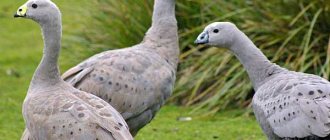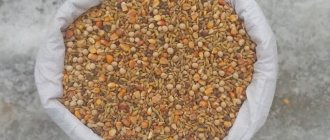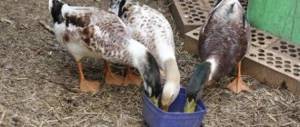Raising young animals
To raise ducks of the favorite breed, no special conditions or special knowledge are required. These birds easily adapt to the climate of any region. However, there are several rules that must be followed for proper development and good weight gain in young animals. They relate to feeding and caring for ducks.
Care and maintenance
Below are the main points that you need to pay attention to when keeping Favorite breed ducks. Table 4. Features of care and maintenance of ducks of the Favorite breed
Features of care and maintenance of ducks of the favorite breed
Table 4. Features of care and maintenance of ducks of the Favorite breed.
What to pay attention to How it should be Living Ducks can be kept in ordinary sheds or uninsulated enclosures. The main requirements are that there should be no drafts in the barn, and the roof should not leak during rain. But if the owner lives in northern regions with a harsh climate, the room still needs to be insulated
Bathing These birds need regular water treatments. The ideal solution would be a small pond on the site. There, birds will not only be able to swim, but will also find nutrition in the form of algae. If it is not possible to equip a natural pond, you need to install a bathtub on the site. Regular water treatments will help strengthen the birds' immunity and improve the quality of their down. Walking The excellent immunity of the favorites allows them to walk in any open areas, even if the bird has not been vaccinated against major diseases.
For walks, you need to provide a fenced area with enough grass
Daylight It is important to ensure that the ducks have enough light. For proper development, at least 14 hours of daylight are allowed
Therefore, in winter and on cloudy days, the poultry house needs to be provided with lighting at the rate of 60 W per 3 square meters. m corral. Cleaning The floor in the room is covered with a layer of straw 10-15 cm thick. The litter must be replaced as it gets dirty. Also in the poultry house, general cleaning should be carried out regularly, and drinkers and food bowls should be washed every 2-3 days. This will reduce the risk of infectious diseases. Disinfection To disinfect the walls in the poultry house, you need to periodically whiten them with slaked lime.
Favorite ducks are very calm and friendly birds, so they can be kept in the same pen with other birds. They get along well with ducks of other breeds, chickens and turkeys.
Favorite ducks can be kept with ducks of other breeds
Feeding the ducks
Birds of this breed are completely picky about food. They gain weight equally well both on grain nutrition and on mixed feed. The diet of ducks is selected according to the following rules:
- For active mass gain, birds are fed wet mash. Sliced potatoes and carrots, grain, cottage cheese, milk, and fresh grass are added there.
- Favorites need three feedings a day. Breakfast and lunch consist of mash with the addition of vegetables, and it is recommended to give grain for dinner.
- Walks should be organized so that the ducks can always enjoy fresh grass or algae from a natural reservoir.
- Ducks love combined silage. To prepare it, combine cabbage, cabbage leaves and herb meal. This dish helps to increase egg production and improves the immunity of young animals.
Farmers usually do not have any difficulties feeding their favorite. The bird never reacts to food with indigestion. But only if you feed her fresh food. Spoiled food will in any case cause poisoning, due to which the bird will stop gaining weight.
An adult duck eats from a feeder
Farming Indian Runners
Despite their extraordinary appearance and southern origin, the birds withstand cold European winters with dignity and are generally quite unpretentious in keeping.
Poultry house
The main conditions for their comfortable living are dry bedding and the right amount of food. However, if the goal is to increase offspring, you should provide the ducks with good lighting and a warm room for at least 12 hours every day.
Indian runners in the enclosure
It is recommended that the living area of these birds be fenced off: the area of the site for one individual must be at least 10 m2. Otherwise, the birds will not have enough greenery growing on their territory. If Indian runners live in a closed area, you don't have to mow the grass - the ducks will take on this job. If there is a garden on their territory, the waste of birds will serve as an excellent fertilizer.
Indian runners are good swimmers
Since ducks are water-loving creatures, it is advisable to have a pond near the poultry house. If there are no water reservoirs in the surrounding area, it is imperative to provide the birds with constant access to drinking water. In addition, Indian runners are very clean birds; they love water treatments and love to clean their feathers. The absence of a reservoir can negatively affect poultry productivity.
Feeding rules
From an economic point of view, breeding the Indian runner is a profitable and profitable enterprise. This is due to the fact that these birds are grassland birds that walk in the meadow for days and independently provide themselves with food - snails, plants and insects. Accordingly, in the warm season, the cost of purchasing feed will be minimal. It is only necessary to feed the ducks grain crops in the evenings.
While grazing birds, you need to keep an eye on the ducks - they are quite curious creatures and love to come into the garden to eat vegetables. In closed conditions, birds should be provided with a sufficient amount of fresh greens. Dandelions, dill, green salad, spinach, nettle leaves and mixed feed are suitable for this purpose.
Dandelions will appeal to Indian runners
To properly formulate the diet of an Indian runner, it is necessary to provide him with high-quality food.
| Type of feed | Amount of feed, g per head per day | |
| in winter | in summer | |
| Cereal flour (various) | 120 | 130 |
| Steamed potatoes | 50 | 50 |
| Alfalfa flour | 20 | 20 |
| Carrot | 25 | 25 |
| Sprouted grain | 16 | 16 |
| Gravel, river sand | No limits | No limits |
| Green food | 100 | 100 |
| Bone flour | 10 | 10 |
| Bean flour | 15 | 15 |
| Wheat bran | 30 | 30 |
| Plastin, Roboran | According to instructions | According to instructions |
As can be seen from the table, in the summer, when the duck gets its own food, it needs much less food than in the cold season. Also, do not neglect vitamins and mineral supplements.
Prices for feed additives for chickens and egg-laying birds
Feed additive for chickens and egg-laying birds Royal Feed
Duck and ducklings of Indian runners
Feeding babies is slightly different from the diet of adults. The first days after their birth, they feed mainly on yolks, to which whites are then added. Starting from day 4, you can give them small portions of feed pre-softened in water. A significant advantage of this breed is their good endurance and a very high survival rate after birth. In addition, they require minimal care, and at the age of 1 month they look like adult birds.
Duck food recipes
Description of the breed
The Indian Runner breed is sometimes called the Penguin Duck. Exterior description:
- the body is narrow and elongated vertically;
- feather color from nut to dark brown;
- cheeks do not sag;
- the bone on the forehead is flat;
- rounded chest;
- the sides are large;
- arched back;
- the head is small;
- wedge-shaped beak;
- neck thin;
- orange paws;
- penguin-shaped paws;
- shins are pronounced.
The birds are slender, the belly is like a tulip, the wings are pressed tightly to the body. The tail is upturned, short and has 18 tail feathers. The neck is developed in proportion to the body.
They swim well and are active even in winter; they love to dig in snowdrifts.
If there is no pond at the breeding site, then the Indian Runner gets along well without it and has fun running around the field or in an open enclosure. An active lifestyle is a characteristic feature of the breed. They are not nervous, are not afraid of noise, and only start a commotion in the event of a clear threat.
Birds have smooth feathers that fit tightly to the body.
An active lifestyle is a distinctive feature of the breed
The Indian Runner has different plumage colors:
The wild color is characterized by a neck with an emerald tint; on the chest there are more brick-red feathers, which end in a white encircling ring. The tail has more black feathering and some green. The beak is an unusual bright green color. Chocolate shades predominate on the wings.
Coloring Trout is distinguished by red feathers on the chest and burgundy feathers on the back. Their wings are gray, and their beak is the color of young green. Females have an orange beak and a lighter back.
The head of the silver wild birds is black in color. Sometimes there is an emerald tint. The beak of males is either green or white. Females are distinguished by light yellow feathers. White males and hens have equally white plumage. The beaks are the color of ripe lemon.
Black females and males have black feathers with a greenish tint. Their beaks are bright green. Sometimes there are individuals of indeterminate color with spots on the feathers, blue or yellow, with a pea-colored two-tone color.
What diseases can runners suffer from?
Young runner ducks may suffer from the following diseases:
- vitamin deficiency - occurs when there is a deficiency of vitamins in the bird’s body, which will ultimately lead to weakened immunity and rickets;
- cloacitis - inflammation of the bird's cloaca and mucous membranes, the disease occurs due to a lack of vitamins and unsanitary conditions;
- cuticulitis - appears in chicks in the first month of life, symptoms: loose stools and indifference to food.
With an unbalanced diet, ducks develop urinary disease. Under the influence of this disease, ducklings begin to pluck each other's feathers and eat bedding.
If any illness occurs, you should contact a veterinarian. To prevent all possible diseases, you need to monitor the cleanliness of the poultry house and ensure that there is no overcrowding. No more than 8 ducks are allowed per square meter of usable area. In addition, it is necessary to let the ducks swim in the pond (if possible), add mineral components and vitamins to the food.
If you have runners on your household, share your own experience in the comments. This useful article will also be useful to others, so like and share it on social networks.
Description of the breed
The Mulards have collected all the positive qualities of their ancestors. They are distinguished from simple ducks by their cleanliness and calmer disposition. Do they fly like musk ducks - yes, but you shouldn’t clip their wings, since their massiveness prevents them from displaying their flight abilities.
Characteristics of appearance
The birds are large, with a long body, the wings fit tightly. Medium-sized head with dark eyes and yellow beak, long neck. Yellow short legs, small tail. Comparing hybrid individuals with relatives of the musk breed, it is worth noting the smaller body size and smaller growth on the beak, the paws are also shorter.
Color
There are color variations in the color of mulards:
| Color | Description |
| White | The entire body is covered with a single-colored light feather with a black spot on the head. |
| White black | Predominantly light plumage with dark spots on the head, wings and tail |
| White-brown | Light body combined with dark plumage of the head, wings and tail |
Weight and dimensions
Already at 3 months, the duck reaches a weight of 4 kg, which is considered the optimal slaughter weight; with longer rearing, the figure for an adult increases to 7 kg.
Important! 2 weeks before slaughter, birds are switched to a different menu, excluding fishmeal from the diet. This will prevent the meat from smelling unpleasantly.
Lifespan
When approaching the issue of slaughter, it is important to know how long the mullards take to grow: from 1 to 3 months, ducks actively gain muscle mass, with virtually no fat deposits. Based on this, it is clear when to cut a bird. Keeping it for more than the specified period is not advisable, as molting and weight loss begin
Keeping it for more than the specified period is not advisable, as molting and weight loss begin.
On average, the maximum lifespan is about 10–15 years, but hybrids are often used for industrial cultivation and slaughtered long before that. Before killing, they spend several hours of fasting with free access to water. The ducks are chopped and then scalded with hot water to remove feathers.
Having considered the question of at what age and in what month it is recommended to slaughter livestock, let's move on to the next point - sexual dimorphism of mulards.
How to distinguish a drake from a duck
As with musk ducks, sexual differences are weakly expressed.
You can distinguish a male from a female by the following characteristics:
- External signs. The utak is characterized by a more saturated color of plumage; a growth forms on the top of their nose. As for the females, their heads are more rounded, their necks are short and graceful, and their bodies are narrower. The shape of the tail also varies: males have rounded feathers at the end, while ducks have straight lines.
- Features of behavior. In a flock of ducks, the ducks are always in front, and the males stay to the side or behind. It is worth noting the more aggressive behavior of drakes. Females are identified by quacking, and males by whistling and hissing.
- The structure of the reproductive system. Drakes have a fold 3-4 mm thick in the cloaca area, the so-called pseudopenis.
Also learn about the peculiarities of breeding such popular breeds of ducks as Blue Favorite, Star 53, Indian Runner, Bashkir, Agidel, and Peking.
Productive qualities
The main direction of raising ducks is to obtain meat, ensured by early sexual maturity and rapid gain of live weight.
Egg production
Whether ducks lay eggs or not is a frequently asked question among beginning farmers, and the answer is a clear yes. Mulards have inherited early maturity from their Beijing relatives and begin laying eggs from 7–7.5 months of age. About 210 pieces are demolished per year. The nutritional value is no worse than chicken and is used in cooking.
Important! They are contraindicated for consumption in their raw form due to the high risk of salmonellosis infection.
Meat quality
Mulards are a broiler breed; they quickly gain weight, without excess fat deposits, up to 3% of the carcass weight. The meat has high taste qualities: tender, nutritious, without a specific smell or taste. Due to its low fat content, it is recommended to include it in the menu for children.
The calorie content and nutritional value of meat are shown in the table:
| Index | Quantity |
| Squirrels | 19.7 g |
| Giry | 18.8 g |
| Carbohydrates | 0.94 g |
| Calorie content | 248 kcal |
Did you know? Unlike adults, duck meat contains more copper, phosphorus, aluminum, cobalt, silicon, magnesium and sodium.
Pros and cons of the breed
To fully characterize the hybrid, it is important to approach the review comprehensively, studying all the positive and negative features of mulards
- Advantages:
- calm type of behavior;
- cleanliness;
- rapid growth and weight gain;
- high nutritional quality of meat;
- fast adaptation.
- Flaws:
- sensitivity to high humidity;
- sterility.
Breeding Features
Any poultry requires increased attention from the owner, not only in the matter of feeding, but also in organizing suitable living conditions. By observing the requirements for lighting, temperature and air humidity in the poultry house, you will provide the birds with decent living conditions, and they, in turn, will thank you with tasty and healthy eggs.
Content Rules
Despite their “exotica”, Indian runners have good immunity and can live peacefully in a standard duck house, and all that is required of the owner is to maintain the following indicators indoors:
- the temperature of keeping adults is not lower than +5...+3 °C, young animals in the first days of life are not lower than +28 °C;
- air humidity - within 65-70%;
- the duration of daylight hours is at least 12-14 hours (in winter, the lack of natural light will have to be compensated with the help of artificial light sources).
Did you know? For a long time it was believed that the quack of a duck has no echo, but as a result of acoustic studies it turned out that this is not so. In fact, it is simply very similar to the original sound, making it difficult for the human ear to detect the differences.
In addition, it is worth paying attention to the possibility of arranging:
- a sufficient number of spacious nests (calculating 1 piece for 2 ducks), which can be lined with hay or straw;
- a lake or a small swimming pool where birds can swim to their heart’s content (the plumage of waterfowl always remains clean);
- walking area, based on 10 sq. m. per 1 individual (insufficient walking area will lead to massive destruction of vegetation in the fenced area).
A fenced green area will significantly reduce feed costs, because the ducks themselves will be able to obtain a significant part of the nutrients they need. In addition, regular exposure to fresh air will only increase egg production, which cannot be said about birds kept in cages or confined spaces.
Nutrition
The diet of Indian runners is almost completely consistent with the menu of other poultry, the main thing is to take into account the season of the year.
Check out Peking and Bashkir duck.
In summer
In the summer, there is no shortage of food, especially since when free-range, ducks are able to find food for themselves. So, snails, green pasture, insect larvae and worms can serve as food. In addition to this, once a day they can be given:
- grated beets or zucchini;
- wheat;
- corn;
- garden tops;
- food waste;
- roots;
- duckweed from nearby bodies of water.
Also, do not forget about the feeding schedule: the distribution of wheat and corn should be moved to the evening, an hour before the birds go to bed.
in winter
With the arrival of cold weather, there is practically no food on the street, so if you want Indian runners to continue to please you with their high egg production, you will have to take care of their nutritious menu.
Important! In the cold season, warm mash, such as potatoes with bran, becomes especially important for ducks. They can be issued daily.
The number of feedings per day increases to four times, and the food can be:
- boiled potatoes (can be mashed and mixed with bran);
- small cereals;
- compound feed;
- cereals (especially oats, corn, wheat and barley);
- vegetable waste;
- mineral supplements and premixes;
- crushed chalk, shell, crushed shell.
How much to drink?
Water is an important component of any duck’s body, so access to it must be constant. If there may be no bath for birds, then the presence of drinking bowls with clean water is a prerequisite for their good health, and it does not matter whether it is summer or winter outside. The birds themselves will drink as much as they need, and you just have to monitor the amount and purity of the liquid in the drinking bowls.
When do they rush?
Indian runner ducks lay eggs all year round, but the intensity of egg laying depends on an interesting parameter - the color of the birds' plumage. White birds lay more eggs in winter, while black birds lay more eggs in summer. Variegated representatives of the breed do not reduce their productivity throughout the year, of course, if all the conditions for this are created for them (when arranging a poultry house, think carefully about where exactly to place the nests).
You will also have to take into account the purpose of breeding birds, because if the female is busy hatching ducklings and then takes care of them for several more months, then you will not get eggs from her for your table.
Description
A feature of the Agidel breed is its strong immunity to diseases that affect domestic ducks. Individuals obtained as a result of improved characteristics are able to adapt to various environmental conditions and do not require specific care. Duck meat has excellent taste. Representatives of the breed demonstrate high egg production rates. And the white feathers of such ducks are very valuable and are actively used by large light industry enterprises.
Find out what the life expectancy of a duck is and how a female duck differs from a male one.
Appearance
The external characteristics of the Agidel duck differ from representatives of other breeds, especially in the white color of the feathers and relatively large size. Adults of this breed are very beautiful. They have a friendly and calm temperament. The main characteristics of the appearance of birds of this breed are presented in the table:
| Head | Large, long |
| Beak | Wide, orange |
| Eyes | Dark, located high |
| Neck | Long, medium thickness |
| Breast | Deep, protruding |
| Back | Wide and long |
| Torso | Horizontal, muscular |
| Plumage color | White |
| Legs | Short, light orange |
| Wings | Average |
| Weight | The drake has 3.8 kg, the duck has 3.5 kg |
Productive characteristics
Agidel ducks demonstrate high productivity rates. They are a good source of tasty and delicious meat, and can rapidly gain weight when keeping requirements are met. At the age of 6 weeks, the weight of an individual of this breed reaches 3 kg. If you breed these birds for meat, it is recommended to send them for slaughter after 50-65 days. After this period, their feathers become coarser, which is why plucking the bird becomes a difficult task.
Ducks are capable of laying many eggs. One female of this breed can produce up to 260 eggs during the productive period. The eggs are large and regular in shape. The weight of one duck egg ranges from 80-110 g.
Now about the plumage. In terms of its properties and quality, the down of these birds is practically no different from that of a swan. Therefore, at light industry enterprises, clothing is made from this natural raw material, which is especially popular for northern regions with a cold and humid climate.
How to distinguish a drake from a duck
Visible differences between females and drakes in representatives of the Agidel breed become noticeable only a few weeks after birth, when the ducklings grow up and become adult birds.
Did you know? One of the most unusual ways to determine the sex of a duck is to turn the bird upside down. It is believed that in such a situation the drake will actively break free from the hands, and the female will calmly hang upside down and not move.
You can distinguish a male of this breed from a female by the following criteria:
- Appearance. Agidel drakes are always larger than females. Their neck is longer and decorated with a small crest. The shape of the drake's forehead resembles a triangle, and the duck's forehead resembles a trapezoid. Males have curled tail feathers, while ducks have straight feathers. The most popular way to determine the sex of a duckling is to examine the anus. If you place the bird upside down and massage its abdominal area near the cloaca, you will notice a small spiral-shaped penis on the male. If you repeat the same procedure for a female, only spherical growths will be noticeable.
- Voice differences. Agidel drakes are capable of hissing or whistling. Females of this breed, in addition to these sounds, make cackling and characteristic sounds similar to trills.
- Behavior. Determining the sex of ducks based on this characteristic is very inaccurate. Some females may behave like males, especially if the ratio of drakes to ducks in the house is disturbed. It is believed that drakes can start fights near feeders with other males.
Pros and cons of the breed
- Here is a list of their positive qualities:
- rapid weight gain;
- immunity to diseases;
- high value of fluff;
- good egg production;
- ability to adapt to environmental conditions;
- simple maintenance and feeding;
- delicious meat.
- There are few disadvantages, but they still exist:
- increased fat content of meat (especially if there is insufficient amount of grass in the diet);
- possibility of hatching ducklings only from the incubator.
Representatives of this breed have many more advantages, which is why Agidel ducks have become popular for breeding on large and small poultry farms.
Important! Eating raw duck eggs is prohibited. But baked goods prepared using them turn out especially airy and tasty.
Properties of duck eggs and their use
In India and Asian countries, “Indian runners” are raised mainly as an egg breed, since local cooking for centuries has included duck eggs as an independent element and one of the most important components of many national dishes. Until recently, this product was practically not used in the domestic and European food tradition. Recently, duck eggs have begun to be actively produced in many Western European countries, and they have appeared in retail sales. The reason for the increase in popularity was the following circumstances:
- Duck eggs are larger than chicken eggs, they can be obtained all year round, and the cost of production per unit of product is significantly lower than that for eggs of other types of poultry. In addition, the productive life of a laying duck can last 4-5 years, while hens of egg breeds and crosses in the third year of life, as a rule, already reduce egg laying.
- In terms of nutritional content, omega-3 fatty acids, microelements, choline and vitamins, duck eggs are superior to chicken eggs. Their yolk is relatively larger and the white contains less water. Hard-boiled, they are well suited for salads, and when added to dough, they significantly improve the quality of baked goods. Culinary masterpieces such as soufflés and meringues are also better made with duck proteins.
- Duck egg shells are thick and durable; they are easier to store and transport. True, contrary to the claims of some authors, this does not make the product “less perishable.” Its shelf life is approximately the same as that of chicken eggs. Moreover, according to the requirements of sanitary organizations of European countries, warnings about the need for long-term heat treatment (“cook for at least 10 minutes”) must be placed on packages of duck eggs sold in retail stores.
The only significant obstacle to the widespread consumption of duck eggs can be considered their unusual smell and taste. However, this does not apply to the product obtained from “penguins”. The eggs of “runners” (like their meat) are free from this drawback. In taste and aroma they are almost no different from chicken eggs.
The breed is very popular among poultry farmers in different countries.
Indian Runner ducks are productive and unpretentious. Keeping and feeding such pets is easy and relatively inexpensive. In addition, they completely pass on their economic and decorative qualities to their offspring. The initial purchase of hatching eggs or purebred young animals, as a rule, requires serious expenses, but then the breed is successfully bred “in itself,” which significantly reduces costs. The bird produces high quality meat and eggs. We can consider that “runners” are quite worthy of the attention of summer residents and owners of rural farmsteads.
Breeding offspring
An incubator is not required to hatch chicks, since the duck hatches the eggs on its own. The device is used only when the farm does not have its own laying hens. For stable reproduction, families are created of 5 females and 1 drake. Ducks are small, so you can lay no more than 10 eggs on them.
Attention! The breed does not have a mating season. The Indian Runner is ready to breed even in frosty weather
The duck and its offspring are housed in a separate fenced corner. To avoid diseases, the room temperature should not drop below +22, and the humidity should not be above 65%. For the first 3 days, the place with ducklings needs to be illuminated for 20 hours. Rules for feeding young animals:
- 1 – 3 days – crushed yolk;
- Day 3 – introduction of egg whites, wet mash with the addition of chopped herbs, meat broths;
- from 4 days – adding softened feed and chopped vegetables to the diet.
Up to 2 weeks, food is served 8 times a day, from 15 to 30 days - 6 times, after a month - three times.
Advantages and disadvantages
The Indian runner has the following advantages:
- high egg production;
- good body resistance to diseases;
- ducklings grow quickly;
- belong to the grazing species (does not require a lot of feed);
- the taste of the meat is high, the fat content does not exceed 32%;
- the meat is dietary and does not have the specific odor inherent in other types of ducks;
- high demand for hatching eggs and young ducks.
The main disadvantages of this breed:
- difficult to find breeding ducks;
- low carcass weight;
- ducks are very shy and can make noise and fly away at the slightest sign of danger.
Description and characteristics
Consider the description of the runner duck breed:
- rounded breasts;
- slender body, elongated, “bottle-shaped”;
- eye color from light brown to dark brown;
- the length of the beak corresponds to the size of the head;
- the lower legs are well defined, the paws are orange;
- There are 18 drooping feathers in the bird's tail; when walking, they do not reach the surface of the ground.
The duck differs from the drake in its feather cover; the “girls” have an increased number of white feathers. It is much more difficult to determine the sexual characteristics of birds that are black, solid or brown. Here you need to look at the pigment saturation of the bird’s paws and beak. Ducks are lighter in color than drakes. In the latter, upon reaching 3 months, the tail begins to bend in a ring. Another method of determining gender is that “boys” make wheezing sounds, and “girls” quack.
Now Indian runner ducks are used by breeders to obtain new productive breeds. The eggs of this bird are useful for humans, but should be stored for no more than 6 days.
Why are runners bred?
Due to their beautiful appearance, these birds are often included in various exhibitions, but the main purpose of their breeding is to obtain eggs. This is due to the fact that the runner is considered the only representative of egg-laying ducks.
Indian ducks are considered the leaders in egg production among these birds. Their eggs are slightly larger than chicken eggs, last longer and have excellent taste. By the way, products obtained from female runners have a higher percentage of fat than chicken eggs. They contain easily digestible nutrients. The quality of these ducklings' eggs was highly appreciated by confectioners. The yolk instantly whips into foam, making the sweets “weightless”, giving a light texture to any dough and creams.
Is it possible to grow a Mandarin duck at home?
Despite the fact that this bird is exotic, if you have due diligence and desire, you can still raise it at home. Of course, for this you need to have your own house and garden area.
You can grow tangerines on your own plot
Pond arrangement
Since these birds are waterfowl, they will need a pond. The good news: all other members of your household, who also need a pond, will quickly make friends with Mandarin Ducks, since these elegant birds are non-conflict and friendly creatures.
To bring the living conditions of ducks closer to natural, you should:
- or arrange a pond with trees on the shore;
- or dig wooden posts around the perimeter of your lake on which birds can rest.
Mandarin ducks can easily find a common language with their pond neighbors
Warm enclosures
When cold weather sets in, you will need to stop walking the ducks. Do this when the thermometer shows the temperature below 5-7°C. Ducks will need to be driven into insulated enclosures for the winter, which must contain:
- warm straw bedding;
- heated swimming pool.
Ducks will not be able to live without water treatments, so you will have to think carefully and arrange a “sophisticated” poultry house for them.
Mandarin duck in an aviary
Nests for mandarin ducks are made from a dry trunk of a tree, in which hollows are made with convenient attachments. The height of the holes in the trunk should be one and a half meters above the floor.
As for the parameters of each nest, they are as follows:
- the height of the space is at least 60 centimeters;
- width 45 centimeters;
- length 45 centimeters;
- the entrance to the hollow is approximately 15 centimeters in diameter.
Mandarin duck in the petting zoo
Reproduction
It is worth considering that breeding tangerines at home is associated with certain difficulties. For example, in captivity, females often refuse:
- hatching eggs;
- caring for hatched chicks.
In this case, you will have to rely only on the fact that another, more hospitable female will take care of the offspring abandoned by her friend.
Mandarin duck with brood
Nutrition
Additionally, since birds naturally eat large amounts of protein, you will need to provide them with a non-typical avian diet that includes animal proteins, such as:
- cottage cheese;
- eggs;
- fish;
- fish meal;
- meat and bone meal, etc.
Meat and bone meal
In addition, it is also important to include grain crops and their processed products in the menu of these birds, among them the most loved by ducks:
- barley;
- corn;
- sunflower and soybean meal;
- wheat bran.
In spring and summer, tangerines especially need vitamins and fresh fiber. It is convenient to give them:
- water duckweed;
- chopped dandelion;
- plantain.
In the fall, for nutritional reasons, acorns are introduced into the diet, which ducks already feed on in natural conditions without pre-treatment.
During the mating season, birds need strength, so you will have to give them more substantial protein food:
- minced meat;
- minced fish.
In addition, it is also useful to give birds succulent mixtures consisting of:
- carrots, pre-grated;
- wheat bran;
- boiled cereal.
Before serving, grate the carrots
Keeping ducks at home
The duck breed is able to survive the frosty winter. It is important to properly equip the poultry house and follow the feeding diet . It is permissible to replace the river with an artificial reservoir, but the egg production rate will decrease slightly.
An ordinary barn is suitable for keeping Indian Runners. The room needs to be insulated. Cover the floor bedding made of straw, peat, and sawdust. During mild frosts, heating is carried out with red lamps. As the temperature drops, turn on the heater.
The inside of the house is kept dry. Moisture makes ducks sick. Air exchange occurs through ventilation. Drafts are eliminated by sealing cracks. As natural daylight decreases, it is extended with artificial lighting to 12-14 hours.
Advice! Indian runners love to run, so you need to add as spacious a run to the poultry house as possible.
Feeding
From the first days of life, chicks are fed boiled crumbled eggs. Moreover, they begin to give the product with protein on the second day. At first, only the yolk is fed. On the third day, add cottage cheese, semolina and millet porridge to the egg. From the 10th day they are gradually transferred to starter feed.
It is optimal to feed adult animals with store-bought feed for laying hens. In its absence, they try to make the mixture from several types of ground grain. Barley, corn, wheat, legumes will do.
In summer, the main diet consists of greens. In winter, they feed grated carrots, pumpkin, beets, silage, and hay. Homemade feed is enriched with chalk, fishmeal, premixes, and vitamin supplements. The drinking bowls are constantly filled with clean water.
Indian Runner duck - origin of the egg-laying breed
Indian runners are a breed of ducks with a history of more than two thousand years. These birds were bred in the island part of the East Indies. The British took a lot from their colonies, including refugees. They appeared in Great Britain at the beginning of the 19th century. and from there they spread throughout Europe. Charles Darwin named these birds penguin ducks (penguins). The modern name arose much later.
Indian Runner ducks
They were brought to Russia only in 1926 and were not bred as poultry. Runners could be seen at the circus or zoo.
Important! Currently, this species has taken over the whole world. Breeding work to improve runners continues to this day, especially in the USA
Description of the Indian Runner duck breed
These birds are characterized by the following features:
- The body is oriented not horizontally, like most representatives of the Anatidae family, but vertically, like penguins. Hence the first name given by Darwin. Their posture is straight.
- The average height is from 50 to 58 cm. The weight of a male is 2.5 kg, a female is 2 kg.
- One of the main features of the breed is fast running on land. Although such ducks can fly, they do so extremely rarely.
- Their chest is convex and round. The abdomen in healthy individuals does not protrude in relation to the chest. The sides are rounded. The back protrudes slightly. The bird keeps its wings tightly pressed to its body. The tail feathers point downwards. The tail is short, consists of 18 feathers and curves upward.
- The paws are long, with an elongated metatarsus - also reminiscent of a penguin.
- The eyes can be different shades of brown, the saturation depends on the color of the plumage.
- The head is small, with a flat front of the skull. The back is slightly curved. The skin fits tightly around the skull, the skin folds do not sag. The wedge-shaped beak is equal in length to the head. The length of the neck is approximately one third of the body.
Among the running ducks there are birds of different colors.
Black
The raven-colored plumage has a distinct emerald green tint. This is especially noticeable on the head. The beak is also green. Paws are gray. Black birds turn gray in old age, becoming much lighter.
Black slider
Snow-white birds have orange feet and a bright yellow beak (both drakes and ducks).
White color
Trout
The main color of the plumage of such birds is beige, lighter on the belly and throat. There is an open snow-white ring in the neck area. Below the ring on the chest there is a red-brown spot. The beak of males is green, and that of females is orange. The head of the drakes is dark chocolate, with a greenish tint. The back is brown and mottled.
Trout color
Wild color
The appearance of such birds is as close as possible to the coloration of individuals living in the wild. The head is black, with a rich green tint. Below there is a snow-white ring open in the area of the back. The chest under the ring is chocolate-colored. The belly is mostly pearl gray in color. The tail and lower back are anthracite gray with an emerald tint and a white stripe. The wings are ash-colored on top and beige on the inside. They have dark blue mirrors edged with black and white stripes.
Wild Runner
Silver wild
It is a variety of wild color. The mirrors on the wings are dark green, not blue. The head is darker, almost black, the tint can be not only green, but also purple. The ducks are lighter in color, sometimes almost white. In light areas, the feathers have a silvery tint, like indium metal.
Silver wild ducks
Blue
These runners have blue-gray plumage, sometimes interspersed with graphite or black coloring. The beak and paws are dark gray. An olive coloration of the beak with a dark spot at the tip is allowed.
Blue color
How and what to feed ducks?
Food for duck breed Indian Runner
Feeding representatives of the Indian Runner breed is similar to feeding an ordinary duck, but it also has its own characteristics.
- The breed has a good appetite, so there is no need to limit their food intake. A typical, balanced diet for ducks is selected.
- To get truly delicious meat, you need to have mixed feed as part of your diet.
- In the morning, they usually give a mash of greens, vegetables, root vegetables, various additives like bone meal, vitamins and other things.
Important!
In the poultry house and on the run, containers for clean, fresh water must be installed so that the birds can drink if they wish at any time.
- On a free range, the duck finds its own food: insects, snails, plants.
- Cereal porridge is usually served in the evening. They have increased nutritional value, so birds will not get hungry overnight.
- In winter, the bird does not have the opportunity to find greens for itself, so the diet is enriched with silage, sprouted grain, purchased insects, and vitamin supplements.
Egg production
The Indian runner duck is characterized by increased fertility. The indicator largely depends on living conditions and ranges from 150-360 eggs per year. The eggs weigh 65-80 g. They are large, white with a blue or greenish tint.
Ducks begin laying eggs at the age of 5-6 months. You can lay eggs on them, but you need to make sure that they can warm them completely.
Bright representatives of the breed are used as exhibition exhibits. Indicators of beauty are a long tail, a compact neck and a large belly.
